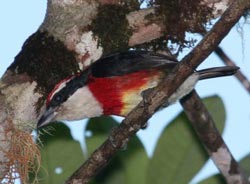New Bird Species Discovered in ‘Cloud Forest’ of Peru

Cornell University<br> <br>The Sira Barbet, Capito fitzpatricki, been discovered and named by Cornell University graduates following an expedition to the remote Peruvian Andes.<br>
The Sira Barbet, Capito fitzpatricki, is described in a paper published in the July 2012 issue of The Auk, the official publication of the American Ornithologists’ Union.
The new species was discovered during a 2008 expedition led by Michael G. Harvey, Glenn Seeholzer and Ben Winger, young ornithologists who had recently graduated from Cornell at the time. They were accompanied by co-author Daniel Cáceres, a graduate of the Universidad Nacional de San Agustín in Arequipa, Peru, and local Ashéninka guides. The team discovered the barbet on a ridge of montane cloud forest in the Cerros del Sira range in the eastern Andes. Steep ridges and deep river gorges in the Andes produce many isolated habitats and microclimates that give rise to uniquely evolved species.
Though clearly a sister species of the Scarlet-banded Barbet, the Sira Barbet is readily distinguished by differences in color on the bird’s flanks, lower back and thighs, and a wider, darker scarlet breast band. By comparing mitochondrial DNA sequences of the new barbet to DNA sequences of its close relatives in the genus Capito, the team secured genetic evidence that this is a new species in the barbet family. The genetic work was done by co-author Jason Weckstein at The Field Museum in Chicago.
The team chose the scientific name of the new species Capito fitzpatricki in honor of Cornell Lab of Ornithology executive director John W. Fitzpatrick, who discovered and named seven new bird species in Peru during the 1970s and ’80s.
“Fitz has inspired generations of young ornithologists in scientific discovery and conservation,” said Winger. “He was behind us all the way when we presented our plan for this expedition.”
The 2008 expedition was made possible by funding from a special gift to the Cornell Lab of Ornithology and donations to the Lab’s student World Series of Birding team, Rawlings Cornell Presidential Research Scholars, National Geographic Young Explorers’ Grant, and the Explorers Club.
Journalists please note:
• A high-resolution image of the Sira Barbet is available at: bit.ly/OFtXhi.
• A copy of the July 2012 Auk paper outlining the find can be downloaded from: bit.ly/OL0SkW.
• Michael G. Harvey is currently pursuing a doctorate at Louisiana State University.
• Glenn Seeholzer is pursuing a doctorate at Louisiana State University.
• Ben Winger is pursuing a doctorate at the University of Chicago.
Media Contact
More Information:
http://www.cornell.eduAll latest news from the category: Life Sciences and Chemistry
Articles and reports from the Life Sciences and chemistry area deal with applied and basic research into modern biology, chemistry and human medicine.
Valuable information can be found on a range of life sciences fields including bacteriology, biochemistry, bionics, bioinformatics, biophysics, biotechnology, genetics, geobotany, human biology, marine biology, microbiology, molecular biology, cellular biology, zoology, bioinorganic chemistry, microchemistry and environmental chemistry.
Newest articles

Silicon Carbide Innovation Alliance to drive industrial-scale semiconductor work
Known for its ability to withstand extreme environments and high voltages, silicon carbide (SiC) is a semiconducting material made up of silicon and carbon atoms arranged into crystals that is…

New SPECT/CT technique shows impressive biomarker identification
…offers increased access for prostate cancer patients. A novel SPECT/CT acquisition method can accurately detect radiopharmaceutical biodistribution in a convenient manner for prostate cancer patients, opening the door for more…

How 3D printers can give robots a soft touch
Soft skin coverings and touch sensors have emerged as a promising feature for robots that are both safer and more intuitive for human interaction, but they are expensive and difficult…





















